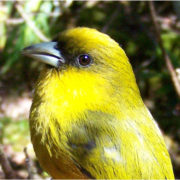KAUA‘I FOREST BIRD PROTECTION AWARDED GRANTS TO RESEARCH AVIAN MALARIA IN HAWAIIAN HONEYCREEPERS
/in Blog, News/by Julia Diegmann(HONOLULU) – The U.S. National Science Foundation (NSF) and the Paul G. Allen Family Foundation has announced a $644,758 grant to the Kaua‘i Forest Bird Recovery Project (KFBRP) to support on-the-ground efforts in its battle against avian malaria. The grant was awarded Tuesday.
A like amount of grant funding was also awarded to the University of Hawai‘i and the U.S. Geological Survey (USGS) for continued research to improve mosquito breeding to create non-viable offspring to reduce the disease transmission to Hawaiian honeycreeper forest birds.
Dr. Lisa ‘Cali’ Crampton, KFBRP Program Manager said, “We are very excited to be involved in this effort to use top-notch science to help us advance conservation of critically endangered forest bird species through reduction of mosquito-borne disease. Funding from the Partnership to Advance Conservation and Practice (PACSP) program will allow KFBRP to better monitor and refine the application and efficacy of a new tool, the Incompatible Insect Technique (IIT), to suppress mosquitoes in Hawaiian forest bird habitat.”
This research is one of 10 projects receiving funding under the PACSP program, a first-of-its-kind collaboration between the NSF and the Paul G. Allen Family Foundation. Now in its second year, the program is designed to catalyze deep collaboration between researchers advancing basic science and conservation partners engaging in on-the-ground conservation.
The projects focus on a range of species, from Hawaiian honeycreepers to grizzly bears and Venus flytraps. The outcomes will have far-reaching implications for biodiversity and conservation, policy, and the economy.
“The fundamental knowledge these projects create, even though related to specific species, will unlock innovative conservation efforts across a broader range of threatened species and ecosystems,” said Lara Littlefield, executive director for programs and partnerships at the Paul G. Allen Family Foundation. “For instance, studying whether mosquitoes infected with bacteria can limit the spread of malaria among birds in Hawaii could ultimately limit disease spread among other animals more broadly.”
Each project extends basic science into on-the-ground conservation to address critical knowledge and data gaps, enabling greater real-world impact to benefit species and ecosystems.
“The unique partnerships this program creates forge a roadmap to broader conservation action by uniting the skills, expertise and tools needed to address the most urgent threats to our natural world,” said Susan Marqusee, NSF assistant director for biological sciences. “These projects also will engage the public, policymakers, law enforcement and others in conservation through education, outreach and other broader impacts.”
David Smith, DLNR Division of Forestry and Wildlife (DOFAW) Administrator commented, “This grant builds on the strong multi-partner collaboration already in place to combat avian malaria as the single-largest threat facing native forest birds, like the honeycreepers. Every little bit helps, particularly currently, when we are facing the strong likelihood of one or more species of honeycreepers going extinct in the very near future.”
# # #
RESOURCES
(All images/video courtesy: DLNR)
HD video – ‘Akikiki egg collection, Kaua‘i (May 10-11, 2023):
Photographs – ‘Akikiki egg collection, Kaua‘i (May 10-11, 2023):
https://www.dropbox.com/sh/ub9d8rq35b1zu4z/AACSUGGUfBdknMOC_iK9ea8Aa?st=2rdp779x&dl=0
Learn more about the Partnership to Advance Conservation Science and Practice program and view the full list of awards and awardees: https://www.nsf.gov/
Media Contact:
Dan Dennison
Communications Director
808-587-0396
Birds, Not Mosquitoes Partnership Receives Hawaiʻi Conservation Innovation Award
/in Blog, News/by Julia DiegmannThe Birds, Not Mosquitoes (BNM) partnership received the Hawai‘i Conservation Alliance’s (HCA) Conservation Innovation Award on July 31 during the 31st annual Hawai‘i Conservation Conference in Honolulu. The award recognizes new technologies or techniques used in conservation activities that lead to significant advances to the structure or nature of environmental conservation in Hawai‘i. In choosing BNM for the award, HCA noted the speed, cooperation, strategic thinking, and community engagement that characterizes this unique alliance of federal, state, and nongovernmental organizations.
“The Birds, Not Mosquitoes coalition has shown exemplary collaboration that embodies the collective spirit and innovation needed to tackle Hawaiʻi’s toughest conservation challenges,” said Emma Anders, HCA Director. “Thanks to their teamwork and application of cutting-edge science, we are now giving native forest birds a chance at survival. This award is especially significant as it is taking place during Makahiki o Nā Manu Nahele, the Year of the Forest Birds.”
Each of the BNM partners have been working to restore habitat and combat non-native mosquitoes and avian disease, but the rapid collapse of four bird species — the ʻAkikiki and ʻAkekeʻe on Kauaʻi and the Kiwikiu and ʻĀkohekohe on Maui — catalyzed the formation of the partnership focused on suppressing mosquito populations to stop avian malaria from killing them. Since its inception in 2017, the BNM team has collaborated to develop and safely deploy an innovative tool called the Incompatible Insect Technique (IIT). While IIT has been used safely around the world for mosquito-borne diseases that affect human health, this is its first application for conservation.
Following years of rigorous study, analysis, and technological innovation, BNM has successfully and safely conducted releases over the last eight months of more than 15 million nonbiting, infertile male mosquitos across several thousand acres in remote conservation areas on Haleakalā, Maui. Planning is underway to begin deployment over a few thousand acres of remote forests on the Alaka‘i Plateau, Kauaʻi in early 2025.
This work could not have been accomplished without funding support from the Department of Interior’s Hawaiian Forest Bird Conservation Keystone Initiative, the Bipartisan Infrastructure Law, the Inflation Reduction Act, and substantial additional funding from the State of Hawai‘i Department of Land and Natural Resources. The National Fish and Wildlife Foundation is also a major supporter, along with several private foundations, private donors, and nonprofit organizations.
The BNM partnership includes the following organizations:
- American Bird Conservancy
- Coordinating Group on Alien Pest Species
- Island Conservation
- Hawaiʻi Department of Health
- Hawaiʻi Department of Land and Natural Resources
- Kauaʻi Forest Bird Recovery Project
- Maui Forest Bird Recovery Project
- National Park Service
- The Nature Conservancy, Hawaiʻi and Palmyra
- University of Hawaiʻi
- U.S. Fish and Wildlife Service
- U.S. Geological Survey
The Last ‘Akikiki
/in Blog, News/by MonikaPAYING HOMAGE TO THE LAST ‘AKIKIKI IN THE WILD
Dr. Lisa “Cali” Crampton was featured on KITV, after the following DLNR press release was by Dan Dennison:
When a group of men hiked into a remote mountain valley in April, they knew it could be the last time they saw an ‘akikiki in the wild.
“This was kind of a trip to say goodbye. ‘Akikiki are down to at most, a handful of individuals, maybe even fewer,” said Justin Hite, a longtime field supervisor for the Kaua‘i Forest Bird Recovery Project (KFBRP), now working on mosquito control planning with the DLNR Division of Forestry and Wildlife.
“What do you do at the end of a species? They don’t take any solace from us coming to visit. It was much more about us wanting to be able to say goodbye and to get around them one last time,” Hite added.
Once numbering in the thousands in the stunning valleys and ridges of native forest, their decline in recent years has been predicted and precipitous.
Just when the broad collaboration of government agencies, nonprofits, and countless individuals seemed to be making inroads in protecting the birds from predators like cats and rats, avian malaria upset the equation. Global warming has forced disease-carrying mosquitoes to the higher elevation habitats of the ‘akikiki and other Hawaiian honeycreepers. One by one the deadly disease has picked them off.
“That is the tragedy, right?” asks Dr. Lisa “Cali” Crampton of the KFBRP. “We are seeing this climate disaster, so I apologize (to the ‘akikiki) for what we have done as people. I do want the ‘akikiki to know that we really appreciated getting to know them. You know, were it not for this crisis, I don’t think people would have gotten to know ‘akikiki as well as we have and come to love them as well as we have.”
Their plight has reached far and wide. School children in India named an asteroid after ‘akikiki.
During the recent trip, the team kept an eye out for one female bird, named Pakele. Hite said, “We met her in 2020 and she was exceptional from the start.” In Hawaiian, Pakele means to escape. Three seasons in a row she had successful nests, possibly while being infected with malaria. “She’s like, it doesn’t affect me. She’s kind of this incredible individual.”
For more than a decade, field teams forged personal connections with the birds by naming them and instantly knowing who they were from their multi-colored leg bands.
“This is much harder to talk about than I thought it was going to be. Just recapturing the emotions that we felt, as we know these birds. In my case I spent ten breeding seasons up on the Alaka‘i,” Hite added.
The spiritual connection, as Crampton describes it, is one layer of the extinction of the ‘akikiki. “That’s represented now by one bird like Pakele still being out in the wild. That’s enormously important to my staff. I think it’s enormously important to the public and to cultural practitioners who look at Pakele as representing the hope we have, because she just keeps going. Hopefully she’ll find a mate. Even though they cannot sustain a wild population, they can sustain our hope and that’s critical at this juncture.”
Despite the existence of one, two, or three birds remaining in the wild, the species is considered functionally extinct. The best and only chance for a viable future lies with captive ‘akikiki at bird conservation centers operated by San Diego Zoo Wildlife Alliance. Perhaps one day, after the threat of avian malaria is stamped out, ‘akikiki can be released back into the high plateau, mountains, and deep valleys of Kaua‘i.
“We did our best, given our knowledge and the available science,” Crampton said. “I want us to understand that we’re all in this together. The fate of all these species is collectively the responsibility of humans everywhere in this world. It is our actions that have led to the situation our planet is in. I’d like everyone to just champion the environment wherever they are.”
Climate Change-Fueled Hurricanes Could Harm Hawai’i’s Birds
/in News/by MonikaA recent piece on Hawaii Public Radio about hurricanes and native birds features interviews with Dr. Lisa “Cali” Crampton and Chris Farmer, Hawai’i Program Director of the American Bird Conservancy. Hurricane Iwa, hit Kauai in 1982 likely leading to the disappearance of one of two remaining Kauaʻi ʻōʻō. The lone surviving bird was last recorded in 1987 and may have been lost in 1992’s Hurricane Iniki. Listen to the interview to learn more about the effects of hurricanes on native bird populations.
ALL HANDS EFFORT TO SAVE KAUAʻI BIRDS FROM EXTINCTION
/in Blog, News/by Julia DiegmannBird experts give honeycreepers a lifeline while waiting for mosquito birth control
Bird experts on Kauaʻi are using all the tools in their toolbox to keep critically endangered forest birds from going extinct. One honeycreeper species, ʻakikiki, could disappear from the wild this year due to mosquito-borne avian malaria, with another species, ʻakekeʻe, not far behind. Warmer climates in recent years have allowed invasive mosquitoes to move to higher elevations, increasing the risk of disease to native forest birds. While conservation partners wait for final approval of a proposed mosquito birth control, also known as the Incompatible Insect Technique (IIT), they are stepping up their use of other, more traditional tools to give the birds a lifeline.
August 8 is legislatively designated as Hawaiian Honeycreeper Day, and it’s the day the team from the Kauaʻi Forest Bird Recovery Project (KFBRP) is taking to the skies to expand use of two naturally-occurring bacteria, Bacillus thuringiensis (sold commercially as “Dunk”) and Bacillus sphaericus, to prevent mosquito larvae from hatching in the uplands of Kauaʻi.
These bacteria are harmless to humans but deadly to mosquito larvae. They’re found in soil worldwide, and are widely used in organic agriculture and water treatment. While project staff have used Bacillus to control mosquito larvae for years, it has traditionally been applied by hand while hiking across the many streams and valleys of the Alakaʻi wilderness. Adding an aerial approach allows the team to address a larger area and hopefully save more birds.
Dr. Cali Crampton of KFBRP said, “The increased use of Bacillus should provide a stopgap for ʻakeke’e, allowing the species to avoid extinction long enough to benefit from the proposed mosquito birth control tool. Both Bacillus and the IIT birth control use bacteria to suppress mosquitoes. The two tools are separate but work together to address different parts of the mosquito life cycle: the Bacillus bacteria kill mosquito larvae, while different strains of the Wolbachia bacteria used in IIT result in unviable eggs that never hatch into larvae.
While conservation partners are currently focused on helping birds, people should also see benefits from increased efforts to suppress mosquitoes in Kauaʻi’s mauka regions.
The combined use of organic bacteria and other integrated pest management efforts, such as fixing potholes in roads and overturning containers of standing water, should help popular hiking and camping areas in Kōkeʻe and the Alakaʻi to once again become mosquito-free.
Check out the frequently-asked questions for more information.
Illustration by Kelly Sinclair Vicars.
Raise your leo: Kauaʻi Mosquito Suppression
/in Blog, News/by Julia DiegmannAbout the project
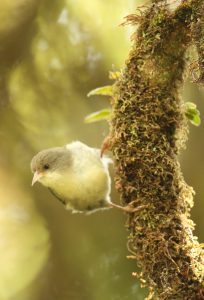
ʻAkikiki, and endangered Kauaʻi forest bird. PC: Justin Hite, Kauaʻi Forest Bird Recovery Project
Hawaiʻi’s forest birds are facing an extinction crisis. Avian malaria transmitted by non-native mosquitoes has decimated native forest bird populations. Of Kauaʻi’s 16 native honeycreepers, 10 have gone extinct. Of the remaining birds, the ʻakikiki is predicted to go extinct by 2025 and the ʻakekeʻe by 2034 (Paxton et al. 2022; see EA for full citation).
The Department of Land and Natural Resources (DLNR) and U.S. Fish and Wildlife Service (USFWS) propose using the Incompatible Insect Technique (IIT) to reduce mosquito populations within approximately 59,204 acres of forest reserves, state parks, and private lands in the Kōkeʻe and Alakaʻi areas of Kauaʻi. This project is intended to suppress mosquitoes known to transmit diseases to native forest birds in critical higher-elevation native forest habitat.
The USFWS and DLNR are preparing a joint environmental assessment (EA) to address the impacts of the release of male mosquitoes with incompatible Wolbachia in the Kōkeʻe and Alakaʻi Wilderness areas. This EA provides background information concerning IIT and outlines the proposed action, potential impacts, and strategies to avoid and minimize potential negative effects of the proposed release of incompatible male mosquitoes within the project area on Kauaʻi. The EA is available below.
Both DLNR and USFWS are members of Birds Not Mosquitoes, a multi-agency partnership urgently working to protect the native Hawaiian honeycreepers from extinction. In addition to the EA below, users may want to review the educational information on this partnership site, including a description of how IIT functions, and answers to Frequently Asked Questions about protecting Hawaiʻi’s birds through mosquito control. Users interested in native birds can explore our native bird profile pages.
Read the draft Environmental Assessment
The draft environmental assessment will be available for public comment for 31 days, June 23 to July 24, 2023. The document is available at the following link:
Hard copies are available for review at the Hawaiʻi Document Center and the Waimea, Līhuʻe and Princeville branches of the Hawaiʻi State Public Library.
Raise your leo and submit a comment
In order to be considered, comments must be received on or before July 24, 2023. All comments and materials received will become part of the public record associated with this action. Comments can be submitted in multiple ways:
-
- Online via the comment form here.
- Via email to mosquitocontrol@hawaii.gov
- Via mail, postmarked by July 24, 2023, to: Department of Land and Natural Resources, Division of Forestry and Wildlife, Attn: Mosquito Control Project, 1151 Punchbowl Street, Room 325, Honolulu, HI 96813
- In writing at a public meeting on July 11, 2023, from 5:00 p.m. to 7:00 p.m., at the Kauaʻi Philippine Cultural Center, 4475f Nuhou St, Lihue, HI 96766
Featured in Ka Wai Ola: Native Hawaiian Forest Birds Fight For Survival
/in News/by Monika Check out this cover feature in the OHA newsletter, written by Lisa Eller, discussing why Kauaʻi’s highly endangered ʻakikiki and akekeʻe face extinction without intervention. You can view the article at KAWAIOLA NEWS.
Check out this cover feature in the OHA newsletter, written by Lisa Eller, discussing why Kauaʻi’s highly endangered ʻakikiki and akekeʻe face extinction without intervention. You can view the article at KAWAIOLA NEWS.
KAUA‘I TEAM TRYING TO SAVE NATIVE HONEYCREEPERS PRESSES ON
/in Blog, News, Videos/by Julia Diegmann(ALAKA‘I PLATEAU, KAUA‘I) – From a remote camp, perched on a narrow 3,000-foot cliff, near the top of Wainiha Valley, Justin Hite, and his team from the Kaua‘i Forest Bird Recovery Project (KFBRP), are in the midst of another field season. A season, that is probably the last for the diminutive native Hawaiian honeycreeper, the ‘akikiki.
“This is one of the last places where we’re still seeing a ton of native forest birds, where everywhere else, just in the last couple of years they’ve quickly and suddenly vanished. And we think it’s because of mosquitoes,” Hite explained during a recent eight-day-long egg collection trip.
The usually upbeat and hopeful KFBRP Field Supervisor has lost some of his optimism this season, as before their very eyes he and his crew are likely seeing the last ‘akikiki remaining in the wild. It’s not unexpected, as other members of KFBRP have been documenting increases of disease-carrying mosquitoes on the plateau.
Regulators are on the verge of approving landscape control of mosquitoes in the mountains of Kaua‘i using the Incompatible Insect Technique (IIT), to reduce the likelihood that forest birds will be impacted by avian malaria, carried by female mosquitoes.
While permitting and approval is underway, the KFBRP team continues work in what is arguably some of the toughest terrain around.
Robby Kohley, Director of Aviculture with Pacific Rim Conservation, is the on-site expert working with the forest bird team in the Mohihi region of the plateau.
He’s worked across the Hawaiian Islands and in Alaska and commented, “Each project comes with a different set of challenges. The logistics problems of this project are quite high. Between the weather (mostly wet, muddy, and incredibly steep), and the lack of luck ‘akikiki are having with nests this year, I’d say this one ranks really high on the challenge scale.”
Since late January the recovery teams have been flying into the field, hiking to field camp, and then from there trudging through knee deep mud on unimproved pig trails to reach ‘akikiki nests that had been previously spotted.
Using a camera, mounted on a long pole, they’re able to see the condition of the tiny eggs. If they appear to be in good shape, they then rig up a tethered ladder system to get a team member high into the forest canopy to collect eggs. They’ll climb as high as 48-feet to get them.
So far, they’ve successfully rescued ten ‘akikiki eggs that are placed in a portable incubator and carried, ever so gently, up the trail to camp. They’re then flown out to a brooder house in Koke‘e State Park and then eventually to the San Diego Zoo Wildlife Alliance Keauhou Bird Conservation Center at Volcano.
Hite notes ‘akikiki in the wild are very good at breeding. However, if avian malaria doesn’t strike them down first, rats are picking them off one-by-one.
“This year is an out-of-control level of nest failures,” Hite explained. Typically, the team finds 30 nests each season and almost all of them would fledge young into the wild. “We spotted a female ‘akikiki sitting on two eggs and when we came back two days later to collect the eggs, we found broken, rat-chewed eggshells on the ground.”
Now the field team has the added pressure of trying to control the rat population by setting out dozens of rat traps. If it’s not one thing it’s another and such is the trial and error, learn as you go attitude necessary to do this kind of work.
Adding to the mental, emotional, and physical stress these dedicated and passionate folks face daily, is the opposition to IIT from a small number of opponents.
At the end of a recent eight-day stint in the field he observed, “These birds are only here. They’ve been here the whole time, long before people arrived in the islands. They’re quiet, unassuming, and wonderful. If we lose them, it’s a huge loss, it’s terrible.”
Clearly the human dimension of the fight to save ‘akikiki and other native forest birds is critical. Watch the short video, Saving ‘Akikiki – The Field Team Presses On, at the link below.


 Graham Talaber
Graham Talaber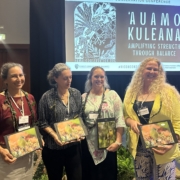


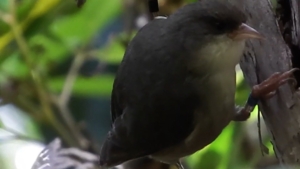

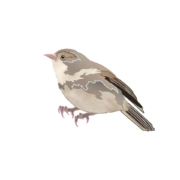

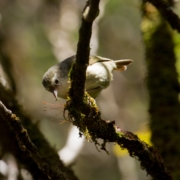 Robby Kohley
Robby Kohley
